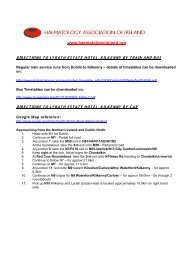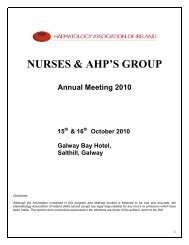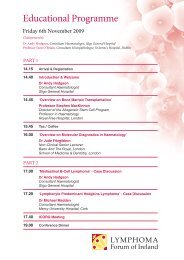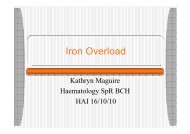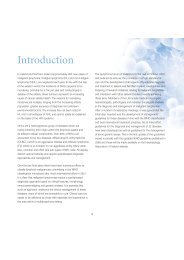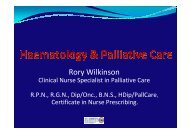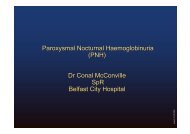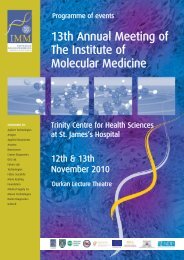Guidelines on Diagnosis and Treatment of Malignant Lymphomas
Guidelines on Diagnosis and Treatment of Malignant Lymphomas
Guidelines on Diagnosis and Treatment of Malignant Lymphomas
Create successful ePaper yourself
Turn your PDF publications into a flip-book with our unique Google optimized e-Paper software.
Follicular Lymphoma<br />
Definiti<strong>on</strong> <strong>and</strong> incidence<br />
Follicular Lymphoma (FL) is a neoplasm <strong>of</strong> follicle centre<br />
B cells (centrocytes/ cleaved follicle centre cells (FCC) <strong>and</strong><br />
centroblasts/ n<strong>on</strong> cleaved FCC).<br />
Worldwide FL is the sec<strong>on</strong>d most frequent subtype <strong>of</strong> nodal<br />
lymphoid malignancies. The incidence <strong>of</strong> this disease has<br />
been increasing steadily during recent decades rising from 5-6<br />
cases/ 100,000/ year in the 1950s to about 15/ 100,000/ year<br />
according to recent US figures. It accounts for about a third <strong>of</strong><br />
cases <strong>of</strong> adults with NHL in the USA <strong>and</strong> 22% worldwide.<br />
The incidence <strong>of</strong> FL is lower in Asia <strong>and</strong> in underdeveloped<br />
countries. FL accounts for 70% <strong>of</strong> cases <strong>of</strong> indolent lymphomas<br />
enrolled in clinical trials in the USA. The median age <strong>of</strong> diagnosis<br />
is 59 years with a male: female ratio 1:1.7. It rarely affects people<br />
under the age <strong>of</strong> 20.<br />
ICD-O Codes<br />
Follicular Lymphoma 9690/3<br />
Grade 1 9691/3<br />
Grade 2 9695/3<br />
Grade 3 9698/3<br />
Clinical Presentati<strong>on</strong><br />
FL predominantly involves lymph nodes but also involves spleen,<br />
b<strong>on</strong>e marrow, peripheral blood <strong>and</strong> Waldeyer’s ring. Involvement<br />
<strong>of</strong> n<strong>on</strong>- haematopoietic extra-nodal sites such as skin,<br />
gastrointestinal tract, <strong>and</strong> s<strong>of</strong>t tissues is usually in the c<strong>on</strong>text <strong>of</strong><br />
widespread nodal disease. Primary follicular lymphoma <strong>of</strong> the<br />
skin (cutaneous follicular lymphoma) is rare but is <strong>on</strong>e <strong>of</strong> the<br />
comm<strong>on</strong>est cutaneous B- cell lymphomas.<br />
Most patients have widespread disease at diagnosis with<br />
peripheral <strong>and</strong> central (abdominal <strong>and</strong> thoracic) nodal<br />
enlargement as well as splenomegaly. B<strong>on</strong>e marrow involvement<br />
is found in 40% <strong>of</strong> patients at diagnosis <strong>and</strong> <strong>on</strong>ly 30% will have<br />
stage I/II disease. Most patients are asymptomatic apart from<br />
lymph node swelling, despite widespread disease. The disease<br />
is characterised by a recurring <strong>and</strong> remitting course (usually in<br />
resp<strong>on</strong>se to treatment) over several years with increasing<br />
resistance to chemotherapy <strong>and</strong> radiati<strong>on</strong> over time. Death<br />
usually occurs due to bulky, resistant disease or high grade<br />
transformati<strong>on</strong> to diffuse large B-cell lymphoma (DLBCL)<br />
Pathology <strong>and</strong> Genetics<br />
Four growth patterns can be found in FL (1) follicular (>75%<br />
follicular), follicular <strong>and</strong> diffuse (25-75% follicular) <strong>and</strong> minimally<br />
follicular (< 25% follicular) <strong>and</strong> diffuse (0% follicular). FL is<br />
composed <strong>of</strong> two cell types normally found in the germinal<br />
centre; centrocytes or cleaved follicle centre cells <strong>and</strong> the larger<br />
transformed centroblasts.<br />
26




